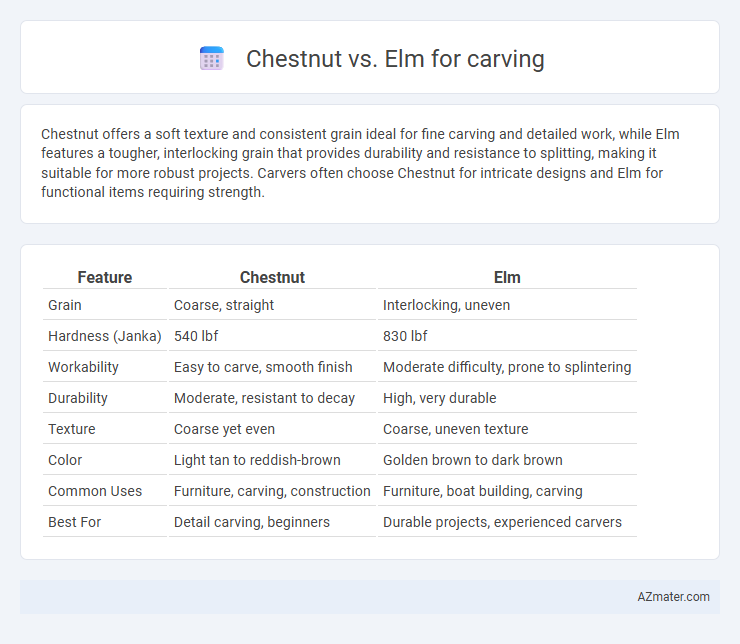Chestnut offers a soft texture and consistent grain ideal for fine carving and detailed work, while Elm features a tougher, interlocking grain that provides durability and resistance to splitting, making it suitable for more robust projects. Carvers often choose Chestnut for intricate designs and Elm for functional items requiring strength.
Table of Comparison
| Feature | Chestnut | Elm |
|---|---|---|
| Grain | Coarse, straight | Interlocking, uneven |
| Hardness (Janka) | 540 lbf | 830 lbf |
| Workability | Easy to carve, smooth finish | Moderate difficulty, prone to splintering |
| Durability | Moderate, resistant to decay | High, very durable |
| Texture | Coarse yet even | Coarse, uneven texture |
| Color | Light tan to reddish-brown | Golden brown to dark brown |
| Common Uses | Furniture, carving, construction | Furniture, boat building, carving |
| Best For | Detail carving, beginners | Durable projects, experienced carvers |
Introduction to Chestnut and Elm Wood
Chestnut wood features a straight grain, medium texture, and is moderately hard, making it ideal for detailed carving projects requiring durability and workability. Elm wood is known for its interlocking grain, toughness, and resistance to splitting, which provides strength and resilience in carved items, especially where intricate shapes are needed. Both hardwoods offer unique characteristics, with chestnut preferred for smoother finishes and elm valued for its structural integrity in carving applications.
Wood Grain Patterns: Chestnut vs Elm
Chestnut features a straight, coarse grain with a consistent texture that makes it ideal for carving detailed designs, while elm displays an interlocking grain pattern that provides strength but can complicate fine carving work. The straight grain of chestnut allows for smoother cuts and less tool wear, enhancing precision in woodworking projects. Elm's unique grain patterns offer a distinctive aesthetic but require skilled handling to avoid tear-out during carving.
Hardness and Workability for Carvers
Chestnut offers moderate hardness with a Janka rating around 540, making it easier for carvers to shape intricate details without excessive wear on tools. Elm, with a slightly higher Janka hardness near 830, provides greater durability but can be tougher to carve for beginners due to its interlocked grain pattern that affects smoothness. Both woods possess good workability, yet chestnut's softer texture and straight grain generally appeal more to carvers seeking detailed and refined finishes.
Durability and Longevity of Carved Pieces
Chestnut wood offers moderate durability with a relatively coarse grain, making it suitable for larger, less detailed carving projects where longevity is important but intricate detail is less critical. Elm is known for its exceptional toughness and resistance to splitting, providing enhanced durability and better longevity for finely carved pieces exposed to wear and environmental factors. Both woods resist decay, but elm's interlocking grain structure gives carved artworks greater structural stability and a longer lifespan in demanding conditions.
Color and Finish Options
Chestnut wood features a warm, golden-brown hue that darkens gracefully over time, providing a rich and inviting finish ideal for carving projects seeking a natural, rustic appeal. Elm offers a more varied palette with lighter to medium brown tones and distinctive grain patterns that enhance the texture and depth of carved details. Both woods accept stains and finishes well, but chestnut's open grain lends itself to a smoother, more consistent finish, while elm's interlocking grain creates a slightly more textured surface, influencing the final appearance of carved pieces.
Resistance to Splitting and Cracking
Chestnut wood offers excellent resistance to splitting and cracking due to its straight grain and moderate hardness, making it a preferred choice for durable carving projects. Elm features interlocking grain patterns that provide good flexibility, reducing the likelihood of cracks under stress but requiring careful handling to avoid unpredictable splits. Both woods perform well for carving, with chestnut favored for stability and elm appreciated for its toughness in intricate designs.
Availability and Cost Considerations
Chestnut wood is generally more available and affordable compared to elm, making it a popular choice for carvers working on a budget or in regions where chestnut trees are prevalent. Elm, while prized for its interlocking grain and resistance to splitting, tends to be less abundant and more costly due to its slower growth rate and susceptibility to disease. Cost considerations often tip in favor of chestnut for large or multiple projects, whereas elm's unique texture justifies its premium price for specialized carving work.
Best Uses of Chestnut vs Elm in Carving
Chestnut wood is prized for carving due to its straight grain, medium density, and ease of working with hand tools, making it ideal for detailed sculpting and ornamental pieces. Elm, known for its interlocking grain and toughness, offers superior strength and durability, suited for functional items like tool handles and furniture components that require resistance to splitting. Chestnut excels in fine, decorative carvings, while elm is preferred for robust, utilitarian projects where structural integrity is essential.
Common Tools and Techniques for Each Wood
Chestnut wood, known for its coarse grain and medium hardness, requires tools such as gouges, chisels, and mallets designed to handle its fibrous texture, with techniques emphasizing smooth, controlled cuts to prevent splintering. Elm, with its interlocked grain and higher resistance to splitting, demands sharper, well-maintained tools like skew chisels and carving knives, alongside techniques incorporating precise paring and relief carving to manage its unique grain direction. Both woods benefit from light sanding and finishing to enhance their natural patterns while preserving the integrity of the carved details.
Final Comparison: Which Wood is Better for Carving?
Chestnut offers a softer, more manageable texture ideal for intricate carving and beginners, while elm provides a tougher grain that resists splitting, making it suitable for detailed and durable projects. The choice depends on the carving style; chestnut excels in smooth, fine details due to its even grain, whereas elm's interlocking fibers support robust, outdoor sculptures. For precision and ease, chestnut is preferable, but elm's strength and resilience make it better for long-lasting, structural carvings.

Infographic: Chestnut vs Elm for Carving
 azmater.com
azmater.com